
Kia Sorento (2024)

Introduction
Kia has been in the ascendency for many years now, and the biggest vehicle in its range, the seven-seater Sorento, is an excellent example of the manufacturer's evolution.
Granted, a Kia will never be as desirable as an Audi, BMW or Mercedes-Benz, but the Sorento has steadily grown into a superb SUV.
If you can look past the inevitable badge snobbery, you'll see a well-equipped car that makes excellent sense.
Now sporting various electrification options in the form of hybrids, it's a four-wheel drive vehicle packed full of technology.
The fourth-generation model arrived in 2020 and is now being given a facelift, with a slightly revised front end, new LED arrangement and improved interior.
So, how does it all stack up?
We’ve taken one for a test drive to find out.
Select's rating score* - 3.8 / 5
At a Glance
The front looks more severe than previous Sorentos, with the grille now more imposing, integrating itself into the headlights on each side, with inspiration taken from Kia’s EV9.
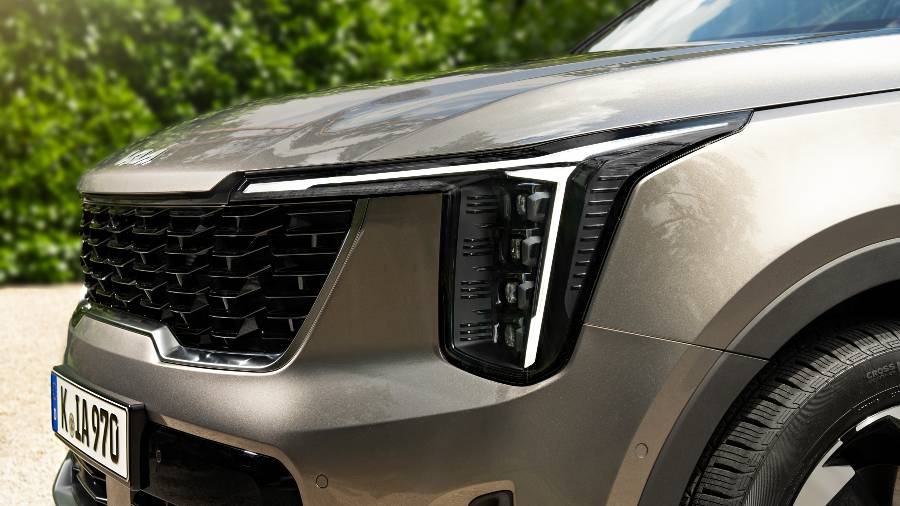
The facelifted version raises the front of the bonnet and flattens the top of Kia’s classic ‘barbell’ grille, with the LED headlight arrangement now thinner and moved away from the side of the grille, taking on a T-shape.
The previously trapezoid-shaped lower grille, which housed the fog lights, is gone, replaced by a more rectangular design.
At the sides, the size of the vehicle becomes apparent, with a long body and indentations in the doors, now with a flatter side skirt, while the windows taper to a point towards the rear.
At the back, a roof spoiler still overhangs the rear window, while the taillights steal the show with two vertical strips on either side, which are now connected at the top.
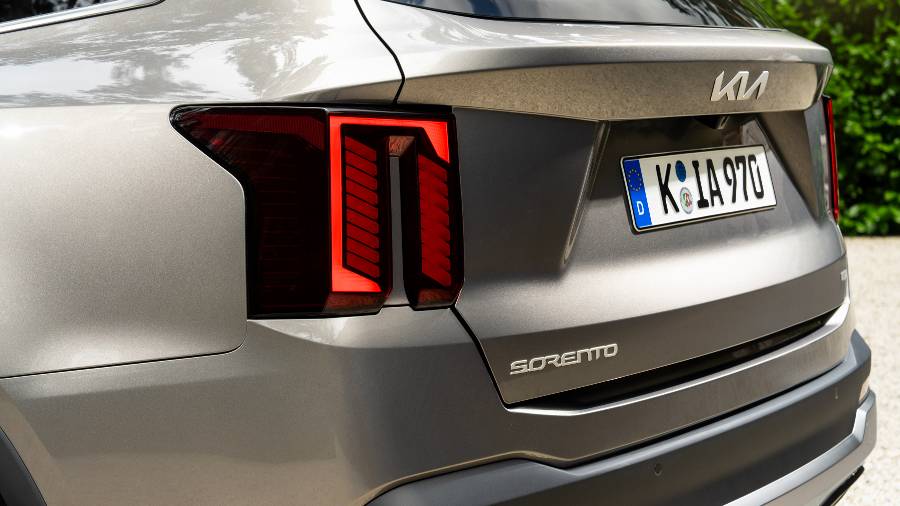
Beneath the tailgate, there’s a chrome panel with thin rear foglights just above it.
Overall, it's a design bound to divide opinion, with some thinking it's superbly attractive and others thinking it's monstrously ugly.
Whether it's good-looking or not, this fourth-generation Kia seems to have less of a soft, family-friendly feel to it, aesthetically speaking. But that seems to have given it personality in abundance.

Key Features
Kia simplified some of its trim levels recently, dropping the numbered editions (which curiously always started with ‘2’).
Nowadays, there are simply two models to choose from on the Sorento.
At entry-level is Vision trim. It comes with a 10.25-inch infotainment touchscreen with SatNav, Apple CarPlay and Android Auto, a wireless mobile charger, and a panoramic tilt-and-slide sunroof with blinds. It also vaunts heated front and outer rear seats, eight-way power-adjustable front chairs, a smart powered tailgate, an engine start/stop button with smart entry, as well as a plethora of safety technology.

The alternative is Edition trim, which comes with a customisable head-up display, 360-degree monitor, black Nappa leather upholstery, ventilated front seats, a Bose Premium Sound System with twelve speakers and a couple of safety upgrades (which, again, we’ll cover later).
Both grades get 19-inch alloys unless you opt for the diesel, which is fitted with 20-inch wheels, though it’s only available in entry-level Vision trim.
The new Sorento has a revised infotainment system, incorporating 12.3-inch screens into a curved panel above the dashboard on higher models. However, a 12.3-inch unit is paired with a 4.3-inch digital instrument cluster on lower models.
In terms of powertrains, there are three to choose from.

The diesel, called CRDi, is a 2.2-litre turbocharged four-cylinder unit producing 201PS.
There is also a full-hybrid (a self-charging hybrid or HEV), consisting of a 1.6-litre turbocharged petrol engine and an electric motor, making 229PS.
Alternatively, you could opt for the plug-in hybrid (PHEV), which consists of the same 1.6-litre petrol unit and a larger electric motor, producing 265PS.
All Sorentos are seven-seaters, and they come with all-wheel drive and automatic gearboxes as standard (six-speed in the HEV and PHEV, eight-speed in the diesel).
We are focusing on the full-hybrid (HEV).
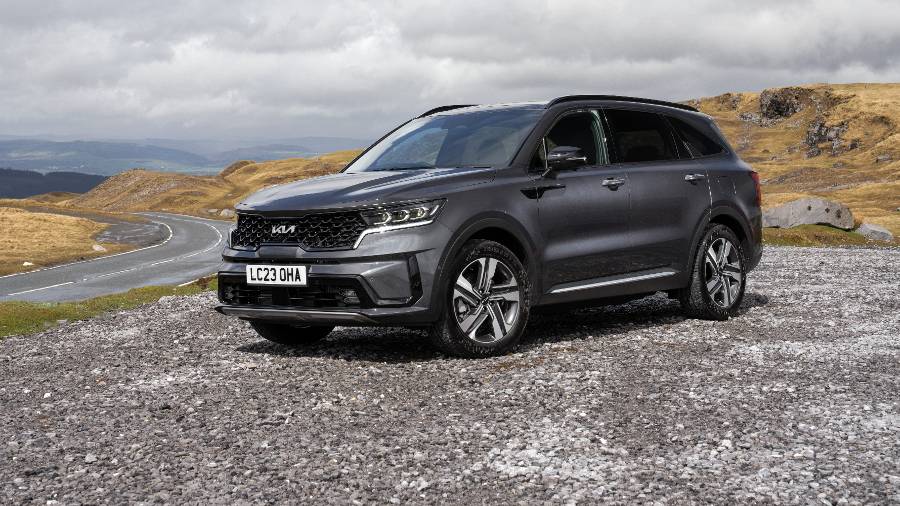
Performance & Drive
Whereas the PHEV has a much larger 13.8kWh battery, the HEV model’s is 1.49kWh.
As a result, the car isn't designed to be run on electric power alone for extended periods. But it can do so for brief periods, such as when making slow progress in stop-start rush hour queues.
There is a momentary delay when you put your foot down, as with most cars with automatic gearboxes, but it eventually sprints off at a decent pace.
Nought to 62mph is dealt with in around 9.0 seconds, meaning it's pretty punchy for such a large vehicle. But we doubt you'll feel it's that keen to move along if you ever have seven adults on board.

On the other hand, the PHEV can do the 0-62 dash in 8.7 seconds, so it's hardly quicker. But it can do a claimed 35 miles on all-electric power (expect less in the real world).
The diesel (whose 0-62mph time is 9.2 seconds) has plenty of torque, too.
As a result, it can tow more than the PHEV (2500kg versus 1500kg and 1,650kg in the HEV we're driving). So, it's very well suited to lugging the extra weight if you're using all seven seats regularly.
As a result, in terms of which is best depends on your needs.
All the powertrains can sound rough when revved hard, and we wouldn't argue that any of them seem more refined.

No SUV handles exceptionally well, but the Sorento is impressive for a car of its size, with plenty of grip to help you around corners. Meanwhile, the steering weights up nicely around bends at speed, which gives you the confidence to push on.
While the handling isn't on a par with SUVs from the likes of BMW and Audi, you'll likely feel the Kia is smaller than its actual size when you go around a corner.
Decent handling usually comes at the cost of ride comfort – unfortunately, the Sorento duly obliges.
The hybrids are heavier thanks to their batteries, so they stick to 19-inch wheels regardless of trim, whereas the diesel has 20-inch alloys.

That makes the hybrids a little more absorbing than they otherwise would be. However, the benefit is offset by the extra weight – and the larger rims of the diesel make the ride a little hard.
As a result, there’s little to choose between the models, though the plug-in hybrid is arguably less adept at dampening the effects of potholes and other imperfections in the road surface.
The additional weight also means that the PHEV feels less agile around corners, with the diesel fairing the best and the HEV somewhere between the two.
Go in too fast, and you'll get a substantial amount of body roll, particularly in the PHEV. But, a specially tuned suspension, which is self-levelling, makes it feel more planted than it otherwise would be.

Running Costs & Emissions
The Kia Sorento HEV we're driving returns 38.2mpg, emitting 167g/km of CO2.
By comparison, you’ll manage 42.8mpg and 173g/km of CO2 if you opt for the diesel.
The real economy is in the PHEV, though, as keeping the batteries fully charged (which you can do at home using a 7kW wall box in around three-and-a-half hours) will result in you being able to reach as high as 176.6mpg, emitting just 38g/km of CO2.
If you want the Sorento as a company car, the PHEV is a no-brainer, as it’s in a much lower Benefit in Kind (BIK) tax band than the other models due to its low emissions and all-electric range. Therefore, it will produce the best savings.
Regarding reliability, although the latest Sorento is relatively new, there should be few worries here.
Kia is one of the most dependable brands – and it’s not afraid to put its money where its mouth is.

Interior & Technology
The Sorento's interior is nice, but whereas it was in keeping with most other Kias before, the facelifted version is far sleeker.
The steering wheel has a large chrome double-spoke at the bottom and features many buttons, while the air vents, which arguably looked a tad awkward before, now only feature on each side.
The vents in the middle are much flatter, giving the whole dashboard a cleaner and almost minimalistic appearance.
Behind the steering wheel, the new curved unit houses the 12.3-inch infotainment screens and digital instrument displays.
The centre console features a couple of cupholders, dials, and a tray to store things.
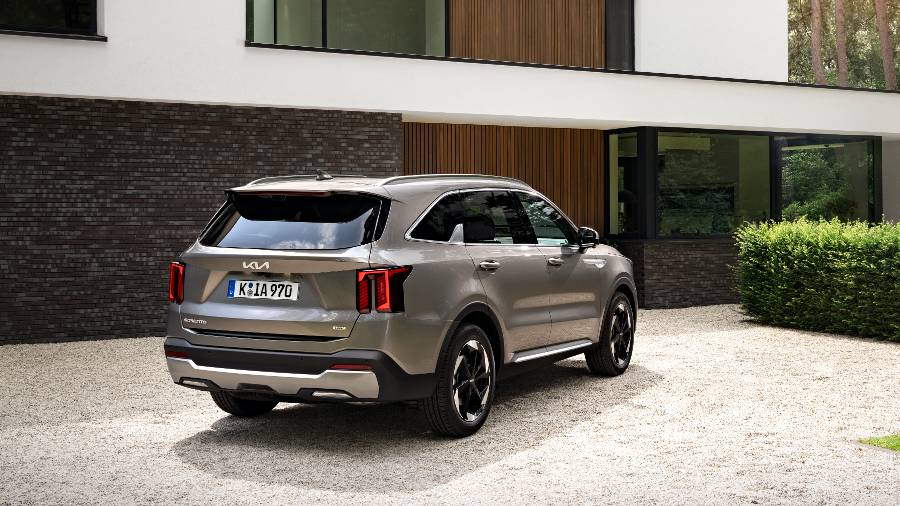
Plush surfaces give a premium feel, and even the harder materials in the cabin don't feel cheap. There isn't a complete absence of thin plastics, but at least they're relatively well hidden.
There is plenty of chrome and silver trim, too, which brightens things up and gives off an air of luxury, while the overall build quality feels solid.
It is not entirely on the same level as the premium brands, but it gives them a good run for their money.
The Kia Sorento’s digital instrument display can be customised by pushing buttons on the steering wheel. And, thankfully, Kia has left the physical switches and dials for the climate control system, which sit beneath the newly shaped central air vents.
The cabin also has eight USB ports, meaning everyone can charge at least one device on the move.
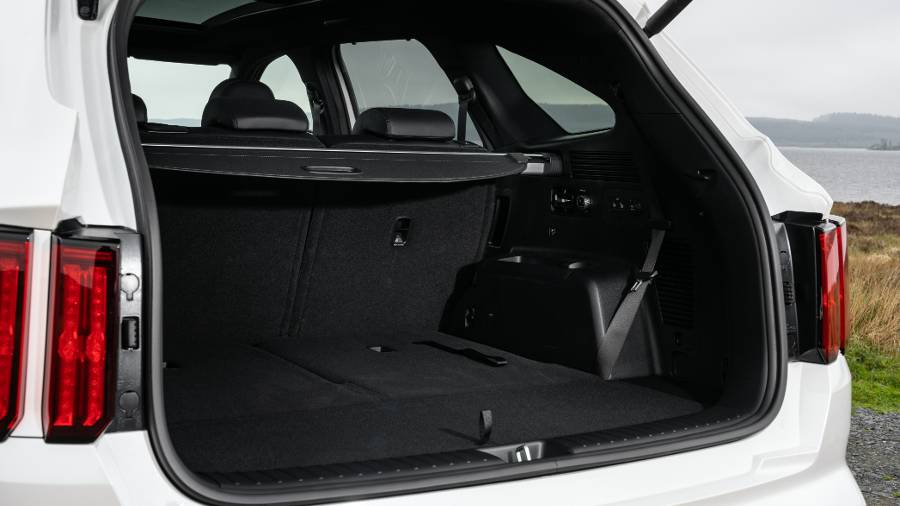
Space & Practicality
Finding a comfy driving position is easy in the Kia Sorento thanks to the electric seat adjustment, which is included on every model as standard, along with a memory function. This feature makes it helpful if you regularly share the driving with someone else.
It also brings with it four-way adjustable lumbar support.
You sit high up, too, which aids the visibility of the road ahead, and the Kia’s front pillars have been kept as thin as possible to help maximise your view.
As in most cars, the rear pillars are quite a bit thicker, especially higher up, but the third side window extends backwards quite far, which helps.

Failing all else, front and rear parking sensors are included on every Sorento as standard, as is a rear-view camera (although this is a 360-degree camera on the top-of-the-range Edition trim that we’re testing).
As you would expect, there’s lots of headroom and legroom in the front of the Sorento, and even the tallest front-seat occupants will find they're well-catered for.
Shoulder room isn’t an issue – you feel like you’re in a different postcode to the other person if there are two of you in the front.
There is a lot of room in the middle row of seats, which both recline and slide, meaning the legroom is almost as accommodating as it is in the front – and fitting three grown adults side by side is not a problem.
In the very back, the rear seats aren't quite as accommodating, but it's still impressive compared with some of its rivals. And, yes, you can fit adults in the back – they just won't be quite as comfortable as they would be in the middle row.

Thankfully, Isofix points in the rear seats mean you can put small children there, leaving the middle row free for the grown-ups.
As for storage space, there are generously sized door bins and a large cubby underneath the centre console. Meanwhile, another cubby at the bottom of the dashboard houses the wireless phone charger.
Boot space in the Kia Sorento is a generous 616 litres with the third row of seats folded down (608 litres on hybrid versions).
This expands to a massive 2,011 litres (1,996 litres in hybrids) if you also fold down the second row in a 60/40 split – and they fold at the touch of a button in the boot, too.
The seating split is less convenient than the 40/20/40 configuration on some competitors, but there's no load lip to contend with, thanks to the Sorento's flat floor.
There is room for a couple of shopping bags if all seven seats are in use, while the Sorento self-charging hybrid also has some underfloor storage, but this isn’t the case on the plug-in version.

Safety
The Kia Sorento was crash-tested by Euro NCAP in 2020, earning a five-star safety rating.
It scored 82% for adult occupants, 85% for children and 87% for safety assists.
A comprehensive amount of safety technology comes as standard on the Kia Sorento, including automatic emergency braking, highway driving assist, lane-keep assist, blind-spot collision avoidance and rear-cross traffic alert.
Edition trims also get remote smart park assist (which will park and un-park the Kia without you being inside), plus a 360-degree around-view monitor.
The top-spec model also gets a blind-spot monitor camera, which will show a rearward view on the digital instrument display when you put the indicators on. This tech is helpful when you change lanes on a dual carriageway or motorway.

Options
There isn't a vast choice regarding body colours, with only black, graphite grey and white offered, but at least none cost extra.
Additional accessories include chrome decorations, different designs of alloy wheels, a sunscreen, side steps and boot protectors.
Alternatively, piano black mirror caps, boot dividers and organisers, carpets, dog cargo separators, and even coat hangers are offered.
There are also various other lighting options, including puddle lights, boot lights, Kia logo projectors and footwell illuminations, while Kia also sells dashcams.
First aid kits and safety vests are also available. Or, just keep things simple with a Kia key ring.

Rival Cars
There was a time when the word SUV was almost synonymous with seven-seaters, but that's no longer the case following the explosion in popularity of crossover SUVs.
Despite this, the Kia Sorento has several foes, with the Hyundai Santa Fe and the Skoda Kodiaq (below) being its biggest natural contenders.

Both have their plus points, while the Honda CR-V and the Peugeot 5008 are also worth considering.
That said, Kia wants to compete with premium rivals, including the Mercedes-Benz GLB, the Audi Q5 and the BMW X3 and X5.
It will also want to tempt would-be leasers of the Land Rover Discovery Sport, which is similarly priced in terms of your monthly lease.

Verdict & Next Steps
The Kia Sorento is an excellent all-rounder, which promises decent performance, competitive fuel economy, superb practicality and an excellent level of standard equipment.
The self-charging HEV we drove is arguably the one to go for, as you benefit from enhanced fuel economy at a less eye-watering price, as the plug-in hybrid is costly.
That said, if you need the towing capability or if you’re going to be regularly lugging seven adults around, the low-down shove of the diesel might be a better fit.
The PHEV is the best option to lease for tax-saving purposes if you're a company car driver.
In terms of trim, the Edition version is great, but there’s nothing wrong with sticking with the entry-level Vision trim, which has just about everything you’ll need.
Overall, the Kia Sorento is pretty classy, if a little expensive – but Kia has, yet again, done a fine job.

Where to next?
View latest Kia Sorento SUV lease deals - from just £513 per month inc VAT**.
Call us on 0118 3048 688 or hit the green 'Enquire' button for more details.
Looking for a great leasing deal? Check out our incredible range of Special Offers and Lease Deals.
New SUV?Read our latest Reviews and find the right model for you.
Want to know more about leasing? Take a look at our comprehensive Leasing Guides.
Interested in everything motoring? Why not catch up on all the latest Car Leasing News.
**Score based on Select’s unique meta score analysis, taking into account the UK’s top leading independent car website reviews of the Kia Sorento.
**Correct as of 08/04/2024. Based on 9 months initial payment, 5,000 miles annually, over a 48 month lease. Initial payment equivalent to 9 monthly payments, or £4,618.44 (Plus admin fee) Ts and Cs apply. Credit is subject to status.






















